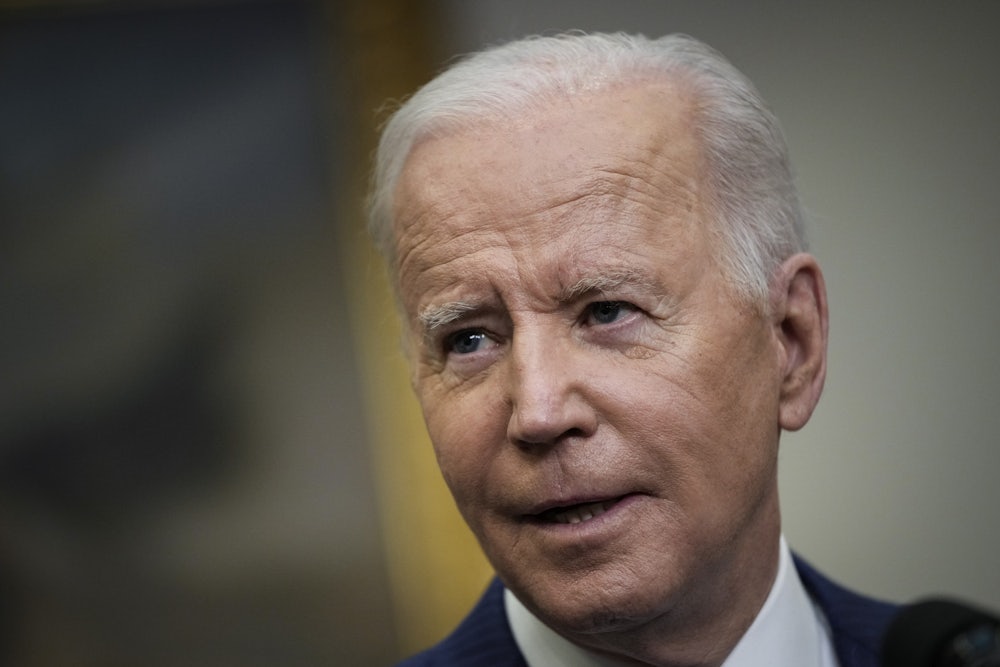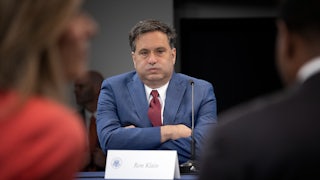There’s a new conventional wisdom emerging to explain the Biden administration’s bumpy first year: He’s “too far left.” Centrist lawmakers, Democratic strategists turned talking heads, and Never Trump conservatives are all jumping on the bandwagon.
It’s curious, considering President Biden’s highest-profile legislative failures didn’t break on his ability to achieve broad consensus among the party. They failed over the obstinance of just two centrist extremists. The cognitive dissonance between the reality and the spin suggests a broader strategy: fearmongering over the left to shift the party to the right.
Consider the aftermath of the disastrous Virginia elections, in which Terry McAuliffe, a white middle-aged centrist former governor who made his name in the party fundraising for the Clintons, was defeated by Glenn Youngkin, a political neophyte. Any objective assessment would suggest that throwback Clinton-era “New Democrats” don’t have a future in the party. But instead, James Carville, the cantankerous former architect of Clinton’s “third way” chalked it up to “stupid wokeness.” Wait, what? No one has ever accused McAuliffe of being woke. Wokeness didn’t lose him the campaign; the fact that he (a) repeatedly mistook his opponent for Donald Trump without articulating a vision for the future and (b) said that one dumb sentence in a debate, about giving parents no say, did.
And then there was Congresswoman Abigail Spanberger, who told The New York Times after McAuliffe’s loss: “Nobody elected him to be FDR, they elected him to be normal and stop the chaos.” Except, as my colleague Michael Tomasky pointed out, Biden himself ran to take on the structural failures that led us to this profoundly abnormal moment. Or at least that’s what he campaigned on: “We have an opportunity … to do so many things now to change some of the structural things that are wrong, some of the structural things we couldn’t get anybody’s attention on.” Surely a big proportion of the 81 million Americans who voted for him elected him to do that.
At the time, perhaps, Spanberger was venting her frustrations with progressives in the House who were holding up the bipartisan infrastructure bill over commitments from Senate centrists to pass the Build Back Better package alongside it. But guess what happened as soon as progressives—save a few members of “the squad”—finally relented and passed the infrastructure bill? Spanberger’s fellow centrist Senator Joe Manchin took to Fox News to declare that he couldn’t “explain” a bill that extended the childhood tax credit, expanded health insurance subsidies, and provided home- and community-based health care … to residents of the one of the poorest states in the nation.
With any attempt to build back paused, the administration turned its attention to voting rights. As Biden himself pointed out in a fiery speech in Atlanta, even segregationist Senator Strom Thurmond came to support voting rights. You might think that rallying the country against state-level efforts to restrict voting access would be a consensus Democratic issue.
Yet even before President Biden could make his way to the Capitol to make his case to Congress a few weeks ago, Senator Kyrsten Sinema (D[?]-Ariz.) took to the floor of the Senate to accuse the president of inflaming a “disease of division,” as she confusingly defended her support of the filibuster and the voting rights legislation the filibuster would preclude. That very evening, David Brooks tweeted, “Today is the day for Biden to begin revamping his presidency in a more centrist direction. There’s no path forward for a leftish agenda.” Brooks himself has decried the fascistic movement that has engulfed the GOP and, with respect to Build Back Better, wrote last September that the reconciliation bill should be $4 trillion! So what’s “leftish” about guaranteeing the right to vote against that party’s efforts to curtail it?
Now centrist knives are out for White House chief of staff Ron Klain, ostensibly for being too close to the party’s left. This is from a recent Washington Post profile:
Some Democrats complained about Klain’s frequent conversations with Congressional Progressive Caucus Chairwoman Pramila Jayapal (D-Wash.), saying they felt that allowed her to influence the White House strategy in a way that has been harmful to the party. White House officials dispute that notion, and Klain said he pushed clearly for an immediate infrastructure vote during a conversation with Jayapal, in which she warned the votes would not be there.
One frustrated Democratic member of Congress, speaking on the condition of anonymity to talk more freely, accused Klain of creating “a monster” by empowering Jayapal, using an expletive to underscore the point.
A “monster”? What is so monstrous about trying to fight for and pass the president’s agenda? That’s basically the job description for the White House chief of staff.
What’s emerging is that centrists believe that if they say it loud enough and in unison, they can create smoke where there’s no fire. But let’s be clear: The problem with Biden’s first year in office is not that he or his chief of staff or the Democratic Party are too far left. It’s that he’s been hamstrung by the forces who want to push the party right in the face of a storm of circumstances that would have flummoxed any administration, from Afghanistan to delta and omicron to a supply-driven inflationary cycle.
What would help the administration right now? Helping the American people, of course. That means solving fundamental problems in their lives, whether access to health care, paid leave, childcare or, perhaps more urgently, the right to vote. That’s been his agenda—and incidentally, the stated agenda of the Democratic Party—all along.






